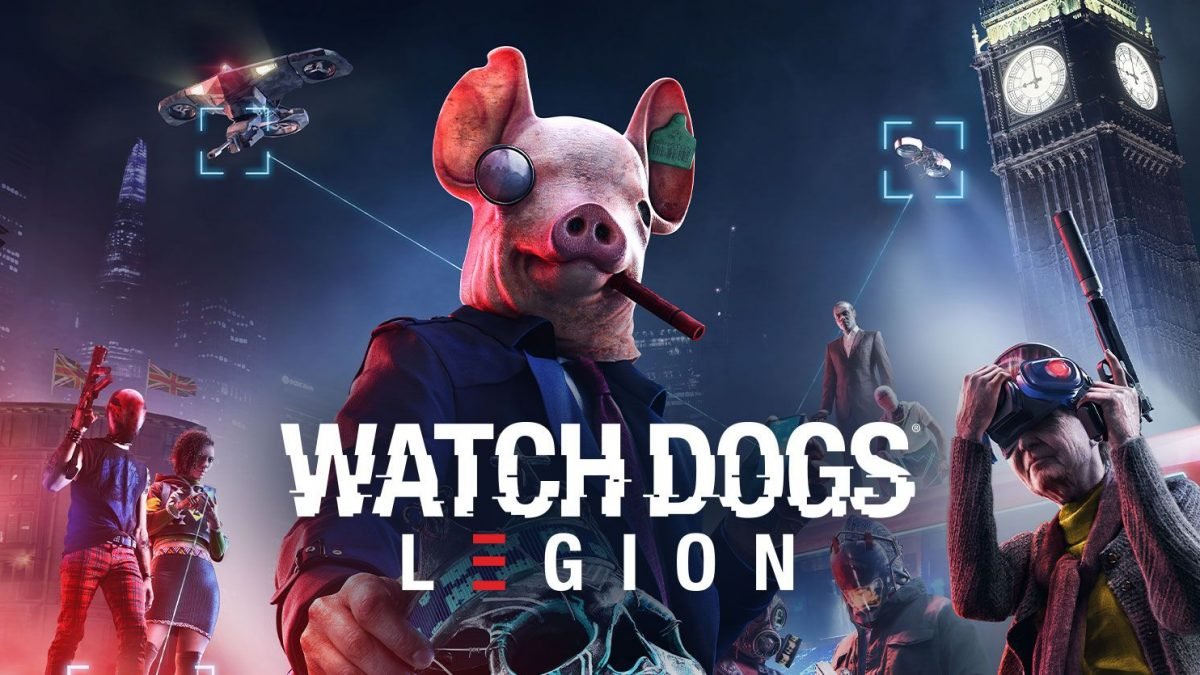(Reviewed on Xbox One by Games of DAYNE)
Hacking your way through London as anybody and everybody is a fun and unique experience at the expense of the story.
Watch Dogs: Legion is the third entry into the open world hackers paradise franchise. Control of the environment and the vehicles and people that populate it has never been more available than this instalment. Watch Dogs: Legion doesn’t put the player in the role of a single protagonist, instead anyone and everyone is able to be recruited to join hacker group DedSec in their mission to clear their name and reclaim a futuristic, dystopian London.
With a city full of people to recruit, regardless of whether they support or despise DedSec, the unique approach adopted by Watch Dogs: Legion allows players to build a team comprised of the likes of professional hitmen, adult entertainers, judges, vice presidents, football hooligans and almost any other profession imaginable. Despite this one of a kind recruitment process, this key feature quickly loses its novelty and in the process the story suffers significantly.
A faceless story
Watch Dogs: Legion opens with a DedSec operative’s desperate attempt to prevent a bomb from destroying a parliament building. Unknown to DedSec, there are more bombs and simultaneous targets. Managing to save only one, DedSec are framed by the emerging Zero Day hacker group, turning London against DedSec alongside the rise of private militia Albion as the city’s peacekeepers. After choosing from a handful of randomised characters, each with their own profession and unique randomly generated background, the player is recruited by the DedSec to take to London and build a resistance to reclaim the illustrious city and prove DedSec’s innocence.

The premise is simply that. Recruit anyone at all, take down Zero Day, save London. The biggest selling point in Watch Dogs: Legion succeeds in the gameplay department but cripples the story, stripping away any attachment to the protagonist and their personal story. By allowing any inhabitant of London to be recruited, these characters are present in the cinematics spitting the same generic dialogue that any other character would, only with a unique appearance and accent to differentiate. This generic characterisation means there is no playable protagonist as such that drives the narrative forward but rather a collective yet disconnected band of insurgents that simply engage with a handful of core characters at the heart of DedSec’s operations. Sabine is DedSec’s fearless leader and she alongside Bagley, an artificial intelligence that communicates directly with DedSec and the player’s operatives, feel more like the protagonist than the player’s actual characters are able to achieve. This faceless story makes the player feel more like just another disposable spoke in the wheel instead of a perspective that drives the story forward.
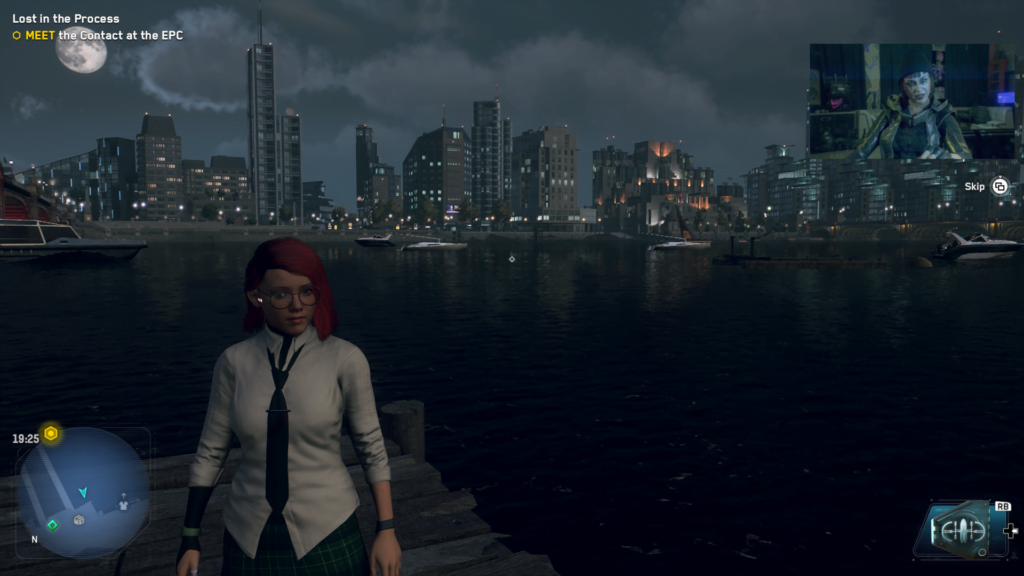
It’s a shame that a story that already strips away the concept of a hero trying to thwart an evil scheme has an extremely predictable outcome at the end of it’s surprisingly short 8-10 hour story. Bringing down key figures from Albion and Clan Kelley, a criminal syndicate operating in the deepest and darkest of activities such as human trafficking and organ selling, DedSec come face to face with the leader of Zero Day before engaging in an anti-climactic finale. While the story of London’s power struggle is interesting in its concept, the dialogue and execution underwhelms. With a significant portion of the story being relayed to the player via earpiece, the lacking face to face encounters between the player and their fellow DedSec supporting characters creates such a disconnect between the player and any sense of emotional attachment to the rebellion they are fighting for. The espionage, infiltration and betrayal would have a greater sense of urgency if the player’s character mattered. Both Watch Dogs titles prior to Legion had a centralised focus on a singular protagonist that gave their actions and motivations weight, giving them a reason to have a mask to hide behind as opposed to wearing a mask because it looks cool, not to conceal the identity of a character that doesn’t matter.
Hackerman
With a futuristic London serving as the playground for the player to explore and control, the non-linear approach to the variety of missions lends to allowing players to tackle the story and the open-world at their own pace. The main missions push the story forward but these aren’t the only things the player can occupy themselves with. A significant portion of Legion’s mission variety comes from the ability to recruit any character to join DedSec. The recruitment process is incredibly simple, which is good in terms of accessibility and the instant gratification todays society seems to demand from video games but bad for its lack of complexity for players who want a little more mileage from the overall experience.
Any character wandering the open world can be scanned, providing a face, name, profession, brief one sentence backstory/fun fact and perks and skills this potential operative brings to the table.
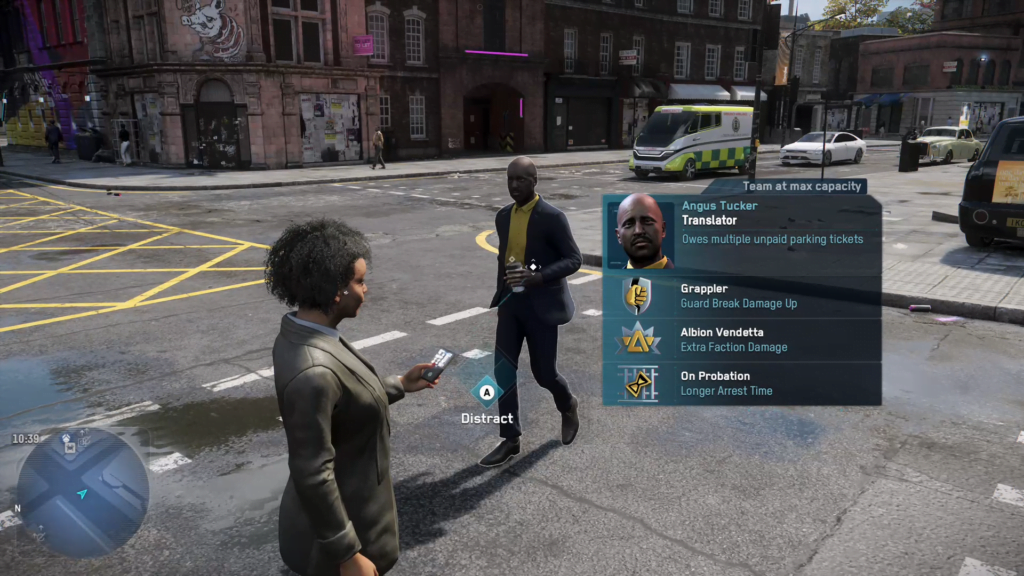
Some characters have unique weapons, personal vehicles and the likes of faction based perks such as the ability to arrest citizens or blend in by wearing their uniforms. This diversity brings a fun assortment of skills that can come in handy for various scenarios. Upon finding a character that seems useful or simply fun to experiment with they can either be added to the Team tab of the menu for future recruitment or in most cases the recruitment can commence immediately with a single button press. Recruitment missions are very brief multi-objective missions that can typically be completed in as little as 5-10 minutes. These objectives are simple and nearly impossible to mess up with the exception of rescue missions where the target, usually a friend of the character the player is trying to recruit, is inadvertently killed. A successful mission means the operative joins the DedSec resistance, becoming playable and can be switched to any time as long as the player is not in a restricted area or being pursued.

Failing the recruitment mission doesn’t close it off entirely, it just becomes more complicated. Some characters have a soured opinion of DedSec and require a slightly different recruitment process, similar to that of failed recruitment missions. By purchasing the Deep Profiler upgrade, these harder to crack potential recruits have a variety of alternative sub-missions to choose from and complete which will then enable, or re-enable, their recruitment mission. These Deep Profiler missions that can be selected vary in the task and may be time of day specific, the latter of which does not apply to all options. Regardless of how the operative is recruited, once they are, they and all of their tools and perks become available, adding to the Team in meaningful ways in regards to combat, traversal or access to places for example. Some operatives are automatically recruited with story progression. A pool of operatives with diverse professions and perks allow the player to have options for how to tackle any situation.

Should one of the operatives be downed in combat, they will be unusable for one hour while they recover in hospital. Having a Doctor or Paramedic recruited will reduce this time by 50%. Similar benefits are applied to having a member of Albion recruited as this will reduce the arrest time if defeated by one of their faction. These perks significantly impact the effectiveness of a team.
At the very start of a new game the player is able to choose whether they want to play in Permadeath mode. This means that once every one of the player’s operatives has been defeated, the game will end and a brand new playthrough will be required. This puts a far heavier focus on who should be recruited to the team than playing the default mode as a reduced recovery time for an operative could be the deciding factor on whether the player is able to survive this harsh mode.
Teched to the nines
The world of Watch Dogs is unashamedly driven by one thing. Technology. In this series, technology is more intrusive, more controlling and more powerful than we can comprehend. Power is dictated by the tech at hacker’s disposal, how it can be controlled and manipulated to push an agenda, typically political. In Watch Dogs, this “power” is literally in the hands of any character controlled by the player via their phone. Controlling cars, drones, security gates and road barriers give enough of an idea to see how the environment can be manipulated in favour of the player.
Tech Points are littered throughout London, within all of it’s regions referred to as Burroughs. These Tech Points are used to upgrade equipable gadgets and weapons as well as upgrades that allow further control and manipulation of enemy weapons and drones for instance. These can all be upgraded 3 times, with each upgrade increasing the effectiveness or performance. There are more Tech Points in the world than are required to fully upgrade all of the tech. The highlight of these upgrades is that they are available for your entire team to have access to, they are not locked to individual operatives.

Playing the part
The core gameplay in Watch Dogs: Legion is similar to the prior instalments. Parkour plays a prominent part in environmental traversal but a very fun and useful new feature is the ability to hijack cargo drones, large enough to climb atop and fly to reach high access points or bypassing gates etc. These can be found in certain areas or summoned from drone pads but the Construction Worker profession is able to summon one of these which makes them a very valuable asset to the team.

There are plenty of pipes and ladders to climb which typically mean there is going to be at least one locked door to get through. Gaining access to these areas either requires a an access key to be downloaded, either carried by an enemy or on a table. These can be hacked remotely by using drones or security cameras to get a clear and close line of sight and requires being in close proximity for the download to occur which only takes a few seconds.
Some areas can only be accessed by the newly introduced spiderbots. These can be summoned as an equippable gadget or by hacking a white box found in some areas. Able to jump and navigate vents, these are very useful and able to get into tight areas high and low.

Enemy weapons can be jammed and enemies can be disrupted, providing ample time to get in close to unleash melee attacks and executions. Melee combat allows for strikes, grabs to break blocks and dodging, allowing for a follow up attack to break their guard. Once taking enough damage the enemy will fall to their knee and a melee takedown becomes available. Depending on the operative’s background and skill set, their melee combat style varies. Some rely on kicks while others can be heavy hitting brawlers. This variety lends towards a more unique feel for the different operatives in regards to their profession and backgrounds.

Gun combat is typically non-lethal and shock based by default, with 4 purchaseable guns available. Certain characters that can be recruited have their own unique weapons such as actual assault rifles, pistols and shotguns. Emphasising again the importance of recruitment as all of this is visible when a potential recruit is initially scanned.
Further personalisation comes in the form of rather extensive customisation. The in-game currency earned from completing missions or hacking ATMs for instance is called ETO and can be spent at a variety of clothing vendors. A very diverse offering of jackets, shirts, pants, backpacks and masks for example can be bought. Each vendor specialises in certain styles with some favouring slicky and formal attires such as suits while others are more chaotic and anarchy inspired, typically with variants of the union jack flag. There are so many different styles to mix and match to create a team full of varied or uniformed operatives.
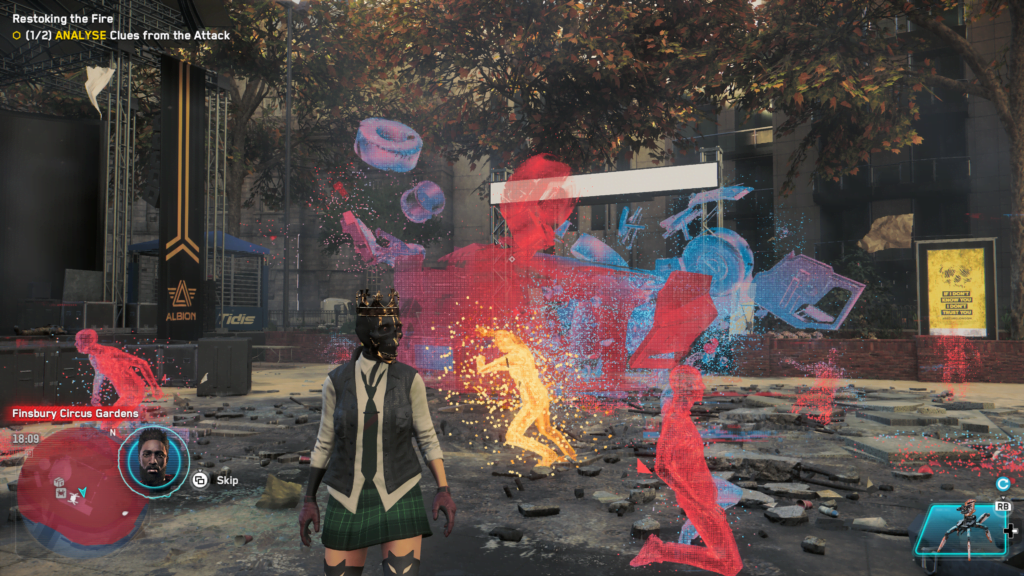
The masks are fun, donned by the operatives when combat is engaged. These can be bought or found in the environment and are crazy, outlandish and wild in the best of ways. A knights helmet, a lion head and skeletons with metallic linings are just a handful of examples of the fun options available to players.
Vehicles are available for the player to cross the city with cars, trucks, buses and motorcycles for instance for the player to steal. A large number of cars are self-driving meaning no driver needs to be removed and therefore no unwanted attention from Albion will be attracted. These vehicles all handle pretty well and are pretty quick, with some able to travel at great speeds. A large offering of fast travel points make it easy for the player to get anywhere throughout the games 8 Burroughs.
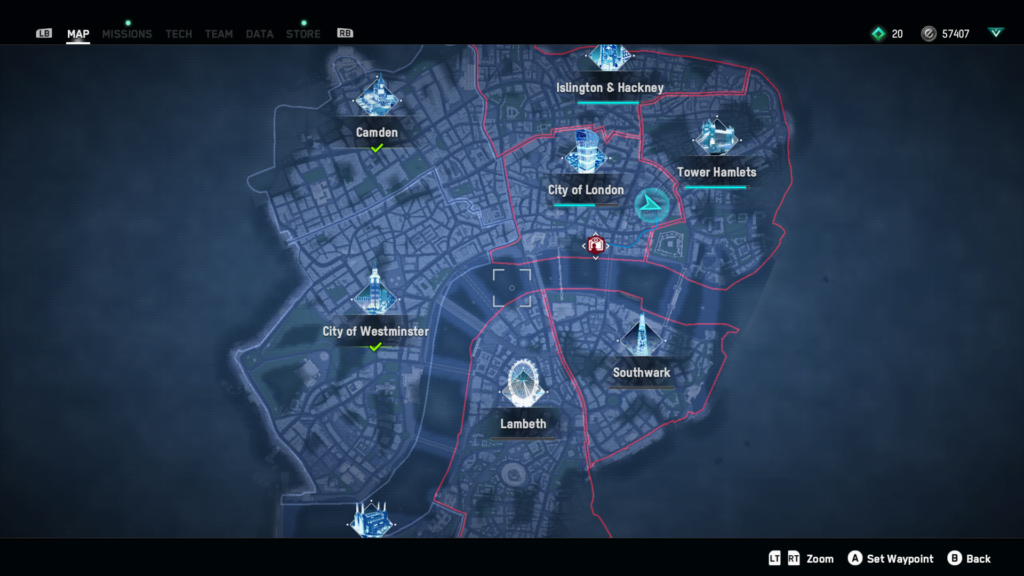
Burroughs can be made defiant by completing a small handful of missions that reinforce DedSec’s public image and its rebellion against Albion, Clan Kelley and Zero Day. These missions are as simple as hacking consoles to replace Albion propaganda with DedSec imagery or taking down key figures in these enemy factions. Having a Burrough become defiant also highlights all Tech Points in the area, making it worthwhile for players looking to capitalise on the generous upgrade tree these Points unlock.
London under siege
The environmental detail is pretty stunning with Ubisoft’s dystopian, futuristic London being arguably the truest representation of the city in any video game. With faithful recreations of iconic landmarks, all under the influence of a tech influenced filter, the city looks and feels alive, full of danger and adventure. The character models are solid, with each character moving pretty authentically and behaving realistic when danger and conflict are nearby.
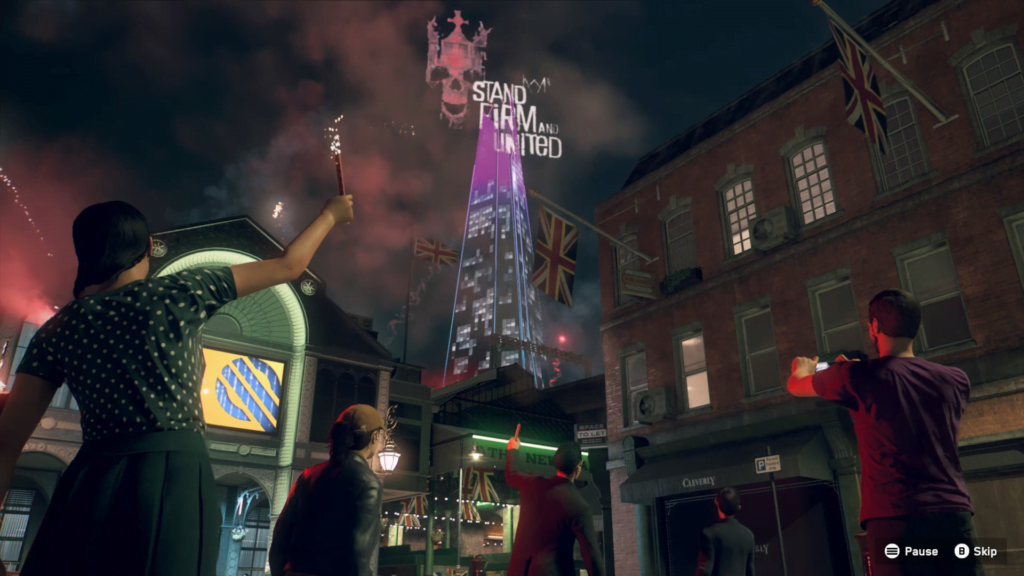
The sound effects and score is appropriately upbeat and energetic, providing an authentic fell to a world overrun by the most powerful and corruptible technology. Watch Dogs looks, sounds, feels and plays like a hackers paradise and Legion’s London backdrop is a perfect playground for players to experiment with the unique gameplay on offer.
Is London worth saving?
Ubisoft have done an incredible job breathing life into a phenomenally realised alternate London. The unique approach to the playable characters offer a lot of fun and variety, rife for experimentation and customisation. The lack of a singular protagonist prevents genuine attachment or investment in their role in the story, which overall hurts the narrative despite its interesting premise.
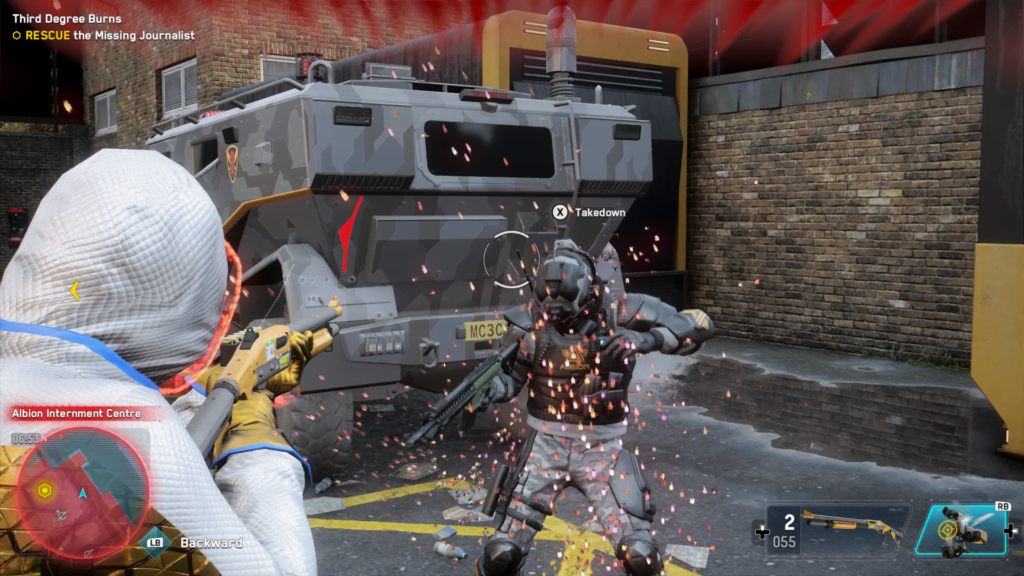
With fun and satisfying gameplay that offers detailed personalisation for each and every recruit, Watch Dogs: Legion easily offers 25+ hours of missions, main and optional, to keep the player engaged and exploring. With random missions becoming available throughout exploration, there is plenty to do and with the inclusion of co-operative and competitive multiplayer modes arriving soon, Watch Dogs: Legion has some staying power that should be a lot of fun with friends.
+ Fun gameplay
+ Interesting recruit anyone mechanic
+ Deep customisation
+ Mission variety
– Story suffers with no playbale protagonist in the traditional sense
Games of DAYNE Rating
Developed by: Ubisoft
Published by: Ubisoft
Release Date: October 29 2020
Platforms: Xbox One, PlayStation 4 and PC

